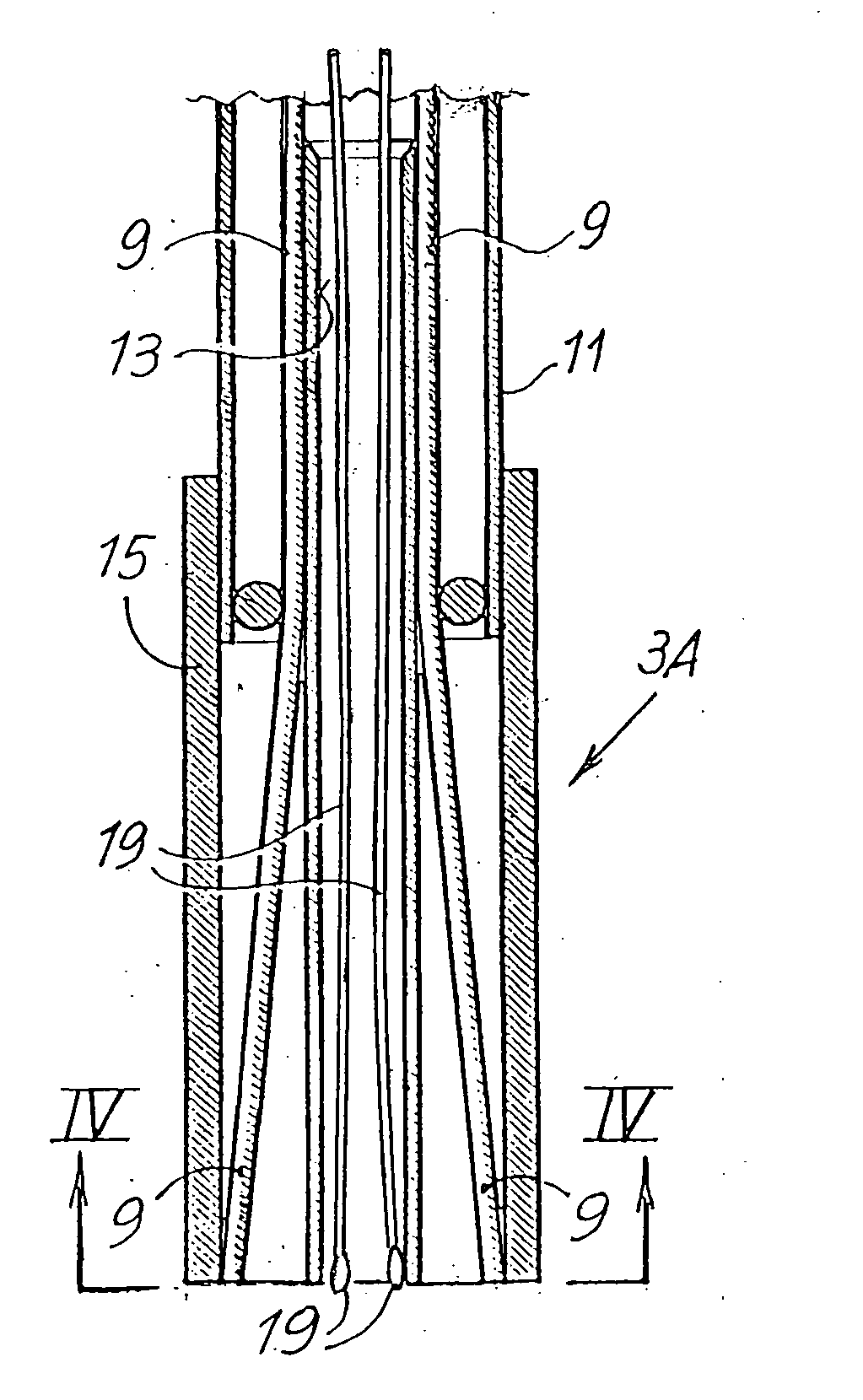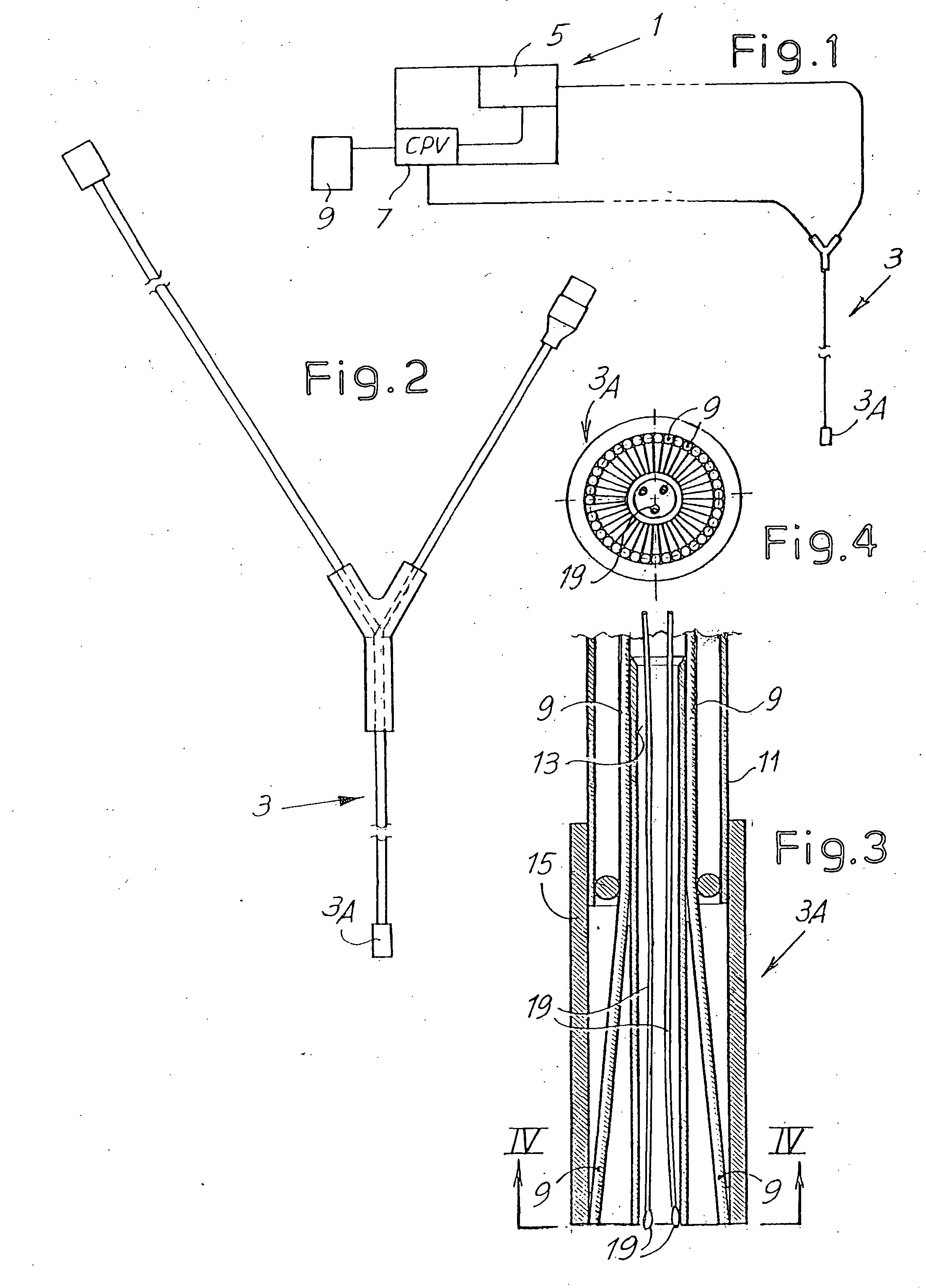[0034] More in particular, the object of a particular embodiment of the invention is to provide a method and a device that will enable a conservative, mini-invasive and
curative treatment, through the
recovery of the tone of the venous wall.
[0035] According to a first aspect, the invention relates to an apparatus or a device for the treatment of varicose veins, comprising a
laser source and at least one optical-
fiber means for conveying the laser radiation either within the vein (intravascular) or outside of the vein (extravascular), in which the
laser source has characteristics of emission such as to cause a hyalinizing sclerosis in the
extracellular matrix of the median coat of the vein by the
photothermal effect, substantially without thermal stress of the morphological component of the tunica media and of the
tunica intima. In contrast with known devices, including ones of more recent conception, therefore, the device of the present invention uses a laser source, the effect of which is such as to preserve the integrity of the
endothelium, and more in general of the intima (comprising the
endothelium and sub-
endothelium) of the treated vessel, in addition to that of the morphological component of the median coat. This enables the
functional recovery of the treated vessel, instead of its demolition, whether functional or anatomical.
[0042] These sensors can advantageously be arranged on elongated elastic elements, which have a movement of extraction and retraction with respect to a terminal housing associated to the end of the
catheter. Said elements can be shaped so as to bend outwards radially when they are extracted from the terminal end of the
catheter. In this way the sensors are brought into contact with the internal surface of the intima, i.e., the innermost coat of the vessel wall, and can detect the temperature in a plurality of points of the wall of the vein. Typically, three sensors are used, for example three thermocouples. This arrangement enables the vein to be kept divaricated by means of the elasticity of the elements that carry the sensors and hence uniformity of
irradiation to be guaranteed. Furthermore, the use of a plurality of
thermal sensors enables
elimination of possible wrong temperature data, due for example to a non-correct contact with the wall of the vessel or else to a malfunctioning of one of the sensors.
[0060] The device used to carry out the method according to the present invention does not require contact with the vessel wall and consequently renders possible treatment only of the tunica media of the vessel, respecting the integrity of the
tunica intima. This can occur thanks to the fact that the method of the present invention uses a light radiation at a precise
wavelength (for example and in particular at 2100 nm), which since it has a particular coefficient of absorption in regard to the chromophores present in the area (porphyrins—
myoglobin and
hemoglobin—water, proteins) concentrates the energy only on the tunica media. In actual fact, the laser radiation involves both the intima and the media in very short times. Since, however, the intima does not have porphyrins (
myoglobin) capable of absorbing an amount of said radiation and since it is very thin, it is, in the first place, far from receptive and above all is immediately cooled by the circulating blood. In fact, the heat absorbed is rapidly yielded to the
venous blood by
convection.
[0063] The laser radiation used in the method according to the present invention, for example and typically at a
wavelength of 2100 nm, is far more selective towards the median coat of the vessel than is the radio-frequency radiation of the known methods extensively discussed above, and does not require particular artifices for limiting its
diffusion, as is instead required for catheters based upon the use of
radio frequency. In fact, with the method proposed herein, the laser radiation can be readily supplied with simple optical fibers of a
diameter greater than or equal to 125 μm.
[0064] The extremely low invasiveness of the procedure underlying the method of the present invention is evident. In fact, such thin optical fibers can be easily inserted via
percutaneous route, i.e., with a needle inserted in the vessel. The
fiber slides easily in the vasal network without ever entering into contact with the endothelium, which thus does not undergo any kind of insult, whether mechanical, thermal, or of any other nature. There is thus also obtained the treatment of vessels of
small caliber and, possibly, of vessels that are particularly delicate in so far as affected by more or less serious forms of
vasculitis. Unlike the methods based upon radio-frequency radiation, moreover, the use of the laser for the
curative treatment forming the subject of the present invention does not require vehicling of a fluid for cooling the vessel wall for the purpose of preventing excessive coagulation thanks to the fact that the cooling action is sufficiently supplied merely by the
blood flow as device of heat exchange by
convection.
 Login to View More
Login to View More  Login to View More
Login to View More 

